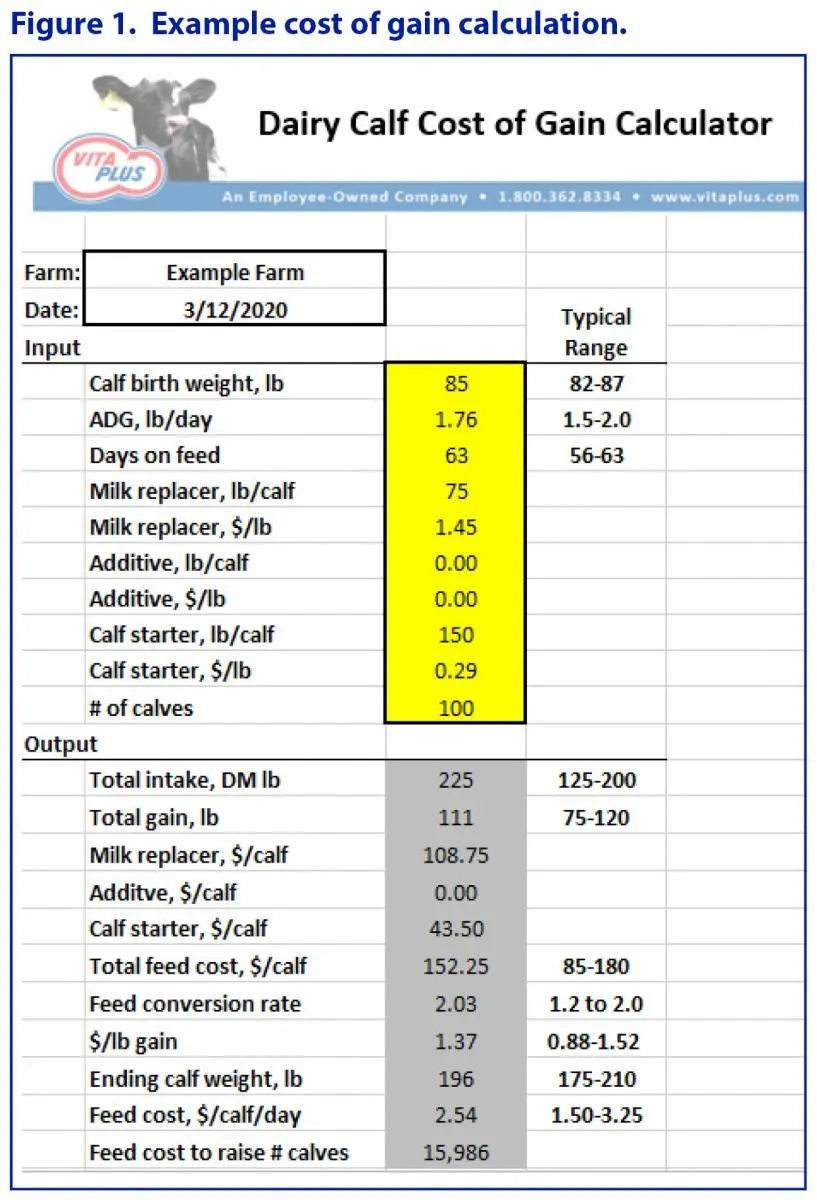
Cost of Gain: Do You Know Your Number?
 Dr. Noah Litherland, Vita Plus dairy youngstock technical specialist
Dr. Noah Litherland, Vita Plus dairy youngstock technical specialistKnowing your feed cost of gain is an important consideration when selecting and evaluating a nursery calf feeding program.
This cost of gain calculator can be used to estimate the cost of gain for a nursery calf program. Follow the directions by completing the input cells and evaluating the output cells.
An example is provided in Figure 1. For this example, birth bodyweight is set at 85 pounds and the days on feed is set at 63 days (nine weeks). The predicted average daily gain is 1.85 pounds per day. In this example, calves were fed a 25/25 milk replacer:
- Day 1 through 7: 4 quarts per day
- Day 8 through 42: 6 quarts per day
- Day 43 through 49: 3 quarts per day
 They were also fed a calf starter with 18% crude protein and Rumensin® ad libitum.
They were also fed a calf starter with 18% crude protein and Rumensin® ad libitum.
Based on the milk replacer feeding regimen, calves are predicted to consume 75 pounds of milk replacer (dry matter basis) and 150 pounds of starter grain. In this example, the cost of the milk replacer is $1.45 per pound and calf starter is $0.29 per pound. Finally, the number of calves raised, or group size, is set at 100 head to determine the total feed costs based on the entered feeding plan.
In the output section, you’ll find a variety of metrics, including:
- Dry matter intake
- Total gain
- Costs of milk replacer, additive and starter grain
- Total feed costs
- Feed conversion rate
- Cost per pound of gain
- Ending calf weight
- Feed costs for individual and groups of calves
Key variables to focus on are the cost per pound of gain ($/lb gain) and the ending calf weight. Cost per pound of gain is a strong indicator of the feed efficiency of the nursery calf program. Ideally, the nursery calf program should achieve an efficient cost of gain and yield a heifer with enough size to transition successfully from the nursery to the grower phase. In the example program, the cost of gain is $1.37 per pound with an ending weight of 196 pounds. Both variables indicate a well-balanced program that can achieve an affordable cost of gain and yield a well-grown heifer.
Primary factors influencing growth
Consider how the following factors will affect your calves’ growth and cost per pound of gain through the nursery phase.
- Calf health: Health challenges increase calf maintenance caloric requirements, decreasing protein and energy available for gain.
- Age: More days in the nursery phase typically results in increased calf growth. Peak calf growth in most calf programs occurs towards the end of the nursery phase.
- Nutrient intake: Increasing nutrient intake from both milk/milk replacer and starter grain increase rate of growth.
- Environment: Thermal stress, air quality and dry bedding are all important components of calf environment that influence calf growth.
- Intake above maintenance requirements: Supplying nutrients in amounts exceeding maintenance requirements results in increased rate of growth.
- Consistency: How you feed is just as important as what you feed. Amount fed, timing of meals, milk replacer mixing, and delivery are all important to maintain feeding consistency and impact both growth and efficiency of growth.
Strategies to decrease cost of gain
- Increase calf growth: Rapid growth rate decreases the cost of gain.
- Efficient growth: Optimizing digestibility and nutrient intake results in a greater amount of nutrients used for growth.
- Positive associative effects: Examples of positive associative effects include balancing starch and fiber in calf starter to optimize rumen function, and formulating milk replacer with osmolality (influenced by lactose and sodium concentration) in the normal range of osmolality of cow’s milk.
- Starter intake: Nursery programs that optimize starter grain intake tend to decrease cost of gain as starter grain cost is about four to five times less per pound than milk or milk replacer.
- Water intake: Water is the most important nutrient. Water intake, quality and hygiene are important factors influencing efficiency of growth.
- Gradual weaning: Changes in amount or type of feed, such as those that occur at weaning, results in changes in nutrient supply, requiring the calf to adjust digestive and metabolic processes. Strategies that allow these changes to occur gradually favor increased feed efficiency.
- Parasite and pest control: Controlling both internal (ex. coccidia) and external parasites (ex. stable flies) increases the efficiency of growth by preventing loss of nutrients robbed from growth.
The cost of gain calculator is useful to predict many economically important variables in the nursery calf feeding program influenced by both feed costs and calf growth. Knowing the cost of gain in your nursery calf program provides you with quantitative measures of calf performance and the ability to critically evaluate feeding program changes on nursery calf cost of gain.
| Category: |
Calf and heifer nutrition Starting Strong - Calf Care Technology and data management |

